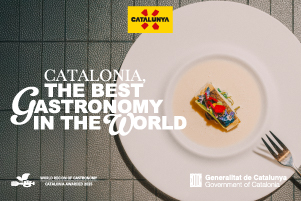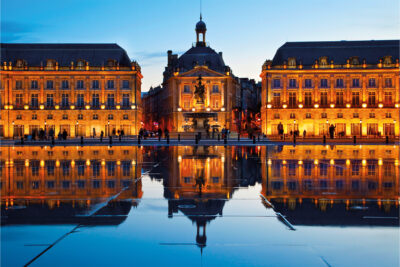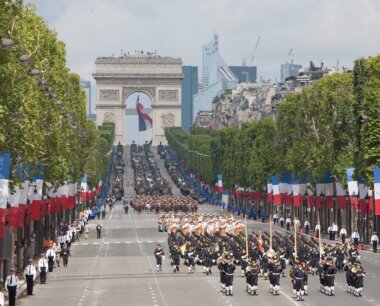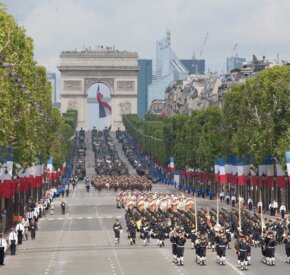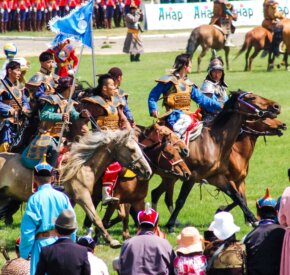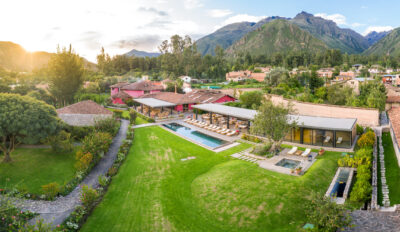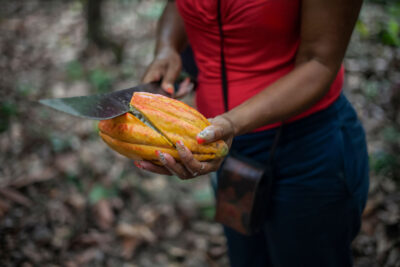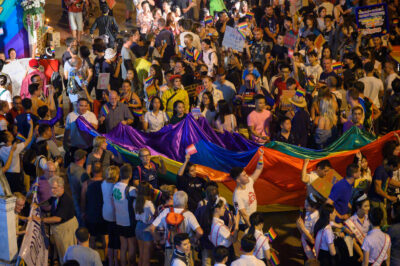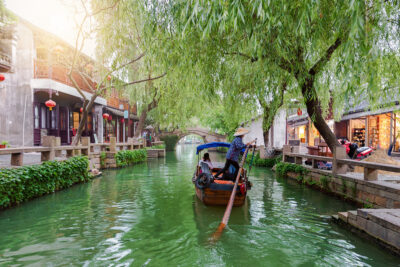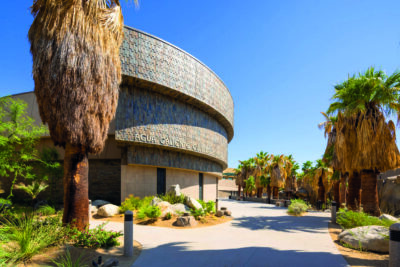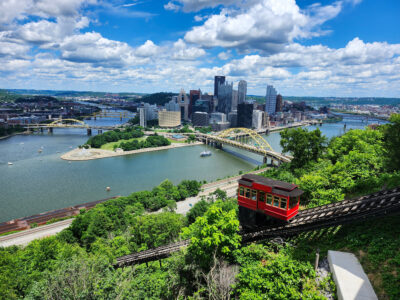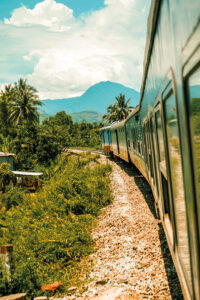
Jungle-swathed mountains, bays studded with islands, jumbo-jet-sized caves. The landscapes alone make Vietnam’s Reunification Express (the informal name given to trains ploughing the north-south railway) one of the world’s most iconic train journeys.
There are great cities, too. The route begins in the north among the shophouses and Confucian temples of old Hanoi and finishes amid the high-rises and Belle-Époque flourishes of Ho Chi Minh City. You could, of course, travel between the two in 38 hours (non-stop). But that’s not really the point. In between lie some of Vietnam’s finest sights, so it pays to take it slowly.
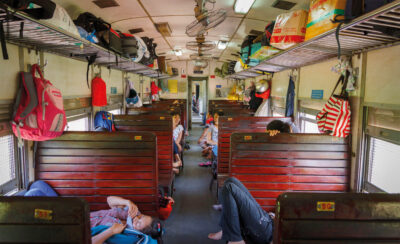
After Hanoi, the next port of call should be Ninh Binh, just over two hours south. Overnighting here gives you time to explore the river-cut gorges of Tam Coc, where little temples decorate the endless rippling mountains. From there, imperial Hue is a night’s sleep away, then it’s a short ride and hop-off for the lovely river-port town of Hoi An, with its Japanese Bridge and tumble-down terracotta cottages. The best beaches are another night away – around Nha Trang and Mui Ne – set beneath a string of haunting ancient Cham tower-temples and an erg of rolling dunes. Ho Chi Minh City is half a day further on.
However, the ‘Express’ is anything but. Trains on this route are typically modest diesel engines with functional air-conditioned couchettes. It’s the journey that sparks joy, as you clatter out of city suburbs and provincial stations and chug sedately through a rural Vietnam of shimmering rice paddies, where locals ride bicycles on country lanes and the silhouettes of untidy harbours filled with fishing boats flit by.
Riding the Reunification Express railway in 2025 is especially poignant. Fifty years ago, Saigon (now Ho Chi Minh City) fell to the Communist North Vietnamese army, with fighting leaving much of the rest of the country a napalm-scorched mess. The railway south had been one of the key US targets in the Vietnam War, with the bridge at Thanh Hoa (inaugurated in 1964 by ‘father of the nation’ Ho Chi Minh) destroyed in one of the world’s first laser-guided bomb attacks.
After Saigon’s fall, and at the behest of the ruling Communist party, workers laboured at breakneck speed to rebuild more than 1,700km of track, 158 stations, 1,334 bridges and 27 tunnels. The railway opened on New Year’s Eve 1976, an emblem of a newly unified Vietnam – independent of France and the USA – that now looked to its own future; one that it has continued to build ever since.
HIGHLIGHTS FROM THE ROUTE
Hanoi & Ha Long Bay
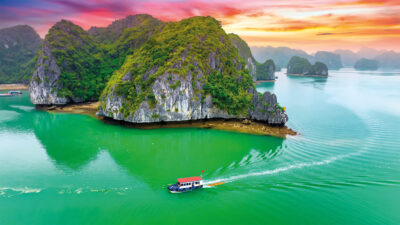
The ‘City of the Soaring Dragon’, as Hanoi was known, spreads around a series of temple-dotted lakes. It’s been an important settlement for more than 2,300 years and was a key centre for both the French and the Chinese of the Tang dynasty. You’ll feel their mark to this day in Art Nouveau mansions on broad boulevards and in the Hànzì characters over the doorways of Confucian shrines huddled among the shop houses of the Old Quarter.
The city is the heartland of the Socialist Republic. Monumental, Soviet-inspired government buildings sit in a giant square next to a vast mausoleum where Ho Chi Minh lies embalmed in a glass coffin. There’s also plenty to see nearby, and Hanoi is a well-serviced springboard for the famous karst-pinnacle islands of Ha Long Bay (170km east). Take an overnight boat to see the best of them.
Read next: 9 of the best things to do in Hanoi
Hue
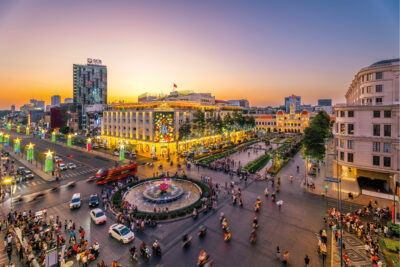
Hue was once the capital of the Nguyen emperors, a dynasty so ruthless in its suppression of opponents that half of Vietnam changed its name to Nguyen to escape persecution. Their vast and imposing Forbidden Citadel sits on the banks of the Perfume River, opposite modern Hue, and is surrounded by countryside filled with temple tombs and porcelain pagodas.
The best way to see it all is to take a day tour in a refurbished GI Jeep. This will whisk you on a whistle-stop tour of the area, including the dragon-gabled Huyen Tran Princess Temple and the tomb of Gia Long, founding emperor of the Nguyen dynasty, whose mausoleum complex is spread among 42 hilltops. In the afternoon, you’ll walk the corridors and palaces of the Imperial City itself, which is slowly being returned to glory, rebuilt from the rubble of the Vietnam War.
Ho Chi Minh City
If Hanoi is ancient, Saigon (as it’s still called by locals) is modern Vietnam. The city is drenched in glittering skyscraper glass and building-high neon. Squeezed among this modernity are old Chinese markets and Belle-Époque French boulevards, opera houses and boutiques. There are still little alleys everywhere, often hiding low-lit speakeasy gin bars with sharp cocktails and velveteen booths, or family-run streetside restaurants where groups of friends gather after work to eat steaming pho (noodle soup) at plastic tables.
Take a guided tour of the jaw-dropping horrors of the War Remnants Museum and the astonishing Cu Chi Tunnels, the hidden underground town built by the Viet Cong and never found by the Americans. This network was one of the launchpads for the North Vietnamese victory of 1975.
Other sites along the way
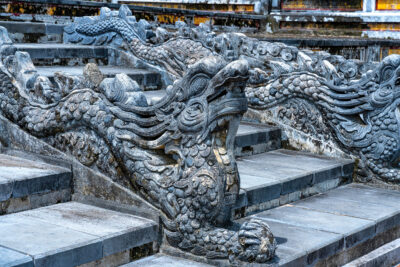
There’s plenty more besides. You can visit all eight of Vietnam’s World Heritage sites from stops along the route. After Ninh Binh and Tam Coc, visit Dong Hoi for the Phong Nha caves. Some are lit and etched with boardwalks, others offer adrenaline rides in the dark or gentle drifts on sampan boats under dripping stalactites. The largest cave network, Hang Son Doong, is so vast that you’d need days to see a fraction of it, camping along the way in cathedral-sized caverns.
You can hole up on the urban beach at Danang or in a lovely boutique hotel in neighbouring Hoi An, an enduringly attractive village of Japanese bridges and tiny temples. From there, it’s easy to catch a boat to the beach-fringed Cham islands to see fishermen bring in their catch in round basket boats. Or you can cycle through the rice-field countryside or wander the ruins of My Son (Vietnam’s Angkor), whose 1,500-year-old temples sit in dense jungle, pocked with B52 bomb craters, under the brow of the rugged mountains.
Need to know
The Reunification Express
The Reunification Express route is managed by state-owned operator Vietnam Railways; prices and timetables in English). Travel in first class for padded couchettes with bed linen and meals (£75 Hanoi–Ho Chi Minh City). There are more comfortable ‘Lotus’ carriages attached to some services; see lotustrain.com for details.
It’s also possible to ride the Reunification Express route for just part of the journey and then connect with an onward flight either within Vietnam or (if you fly from Danang) on to Cambodia and other South-East Asian destinations.
Vietnam is not short of private railway journeys. The brand-new Revolution Express is a vintage steam train that chugs from Hue to Danang, while the luxury Vietage goes from Danang to the beach at Quy Nhon.






